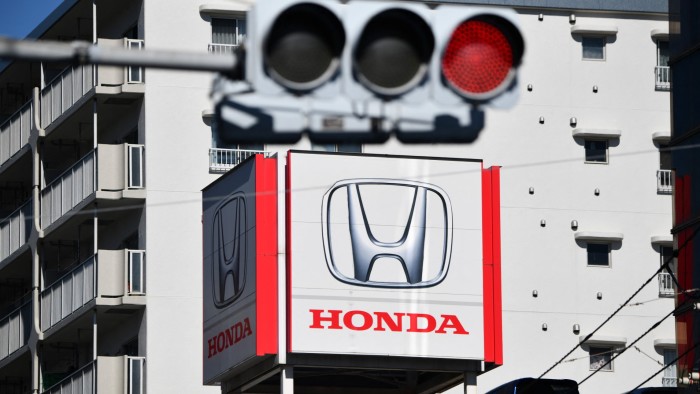Unlock the Editor’s Digest for free
Roula Khalaf, Editor of the FT, selects her favourite stories in this weekly newsletter.
Record motorcycle purchases offset weak car sales for Honda, as Japan’s second-largest automaker officially abandoned $58bn merger talks with its smaller rival Nissan that had been designed to strengthen their competitiveness against China’s electric vehicle champions.
Honda reported on Thursday it had suffered an almost 40 per cent collapse in China car sales in the first nine months of the year, although its pre-tax profits rose 25 per cent to ¥483bn ($3.1bn) in the quarter ending in December due to firm motorbike sales.
Japanese automakers are also under pressure in the US, another major market, from President Donald Trump’s threat to put 25 per cent tariffs on Mexico and Canada, where Honda and Nissan have major production hubs.
Shinji Aoyama, vice-president of Honda, said the company was rushing to export vehicles from the two countries into the US ahead of a 30-day reprieve expiring but warned of a more than ¥20bn impact to full-year profits if tariffs were enacted.
Earlier on Thursday, Nissan and Honda held board meetings to finalise their decision to end talks, with the companies confirming their move in a statement.
Honda had entered discussions in December with Japan’s number-three carmaker to combine into the world’s fourth-largest automotive group, but negotiations unravelled in less than two months, with Nissan bristling at a revised proposal to turn it into a Honda subsidiary.
Attention now turns to how Nissan will survive a cash flow crisis. The company urgently needs support from an outside partner to stabilise its finances, while investors await more details on a sweeping restructuring plan unveiled in November.
Nissan, which is suffering from an outdated product line-up and long-running infighting, follows Honda on Thursday in reporting its fiscal third-quarter results. Analysts expect profits to have shrunk 80 per cent to ¥6bn and cash flow to be positive after the company haemorrhaged ¥606bn in the first half of its year.
For the full financial year ending in March, Honda maintained expectations for net profits of ¥950bn, while Nissan withdrew guidance in November after initially expecting to make ¥300bn.
Executives involved in the negotiations had said Honda was unimpressed by the turnaround plan put forward by Nissan’s Makoto Uchida, judging it would not go far enough to stabilise the ailing carmaker.
As a result, Honda issued a new proposal at the start of the month, which deviated from the original agreement to form a holding company. But Nissan’s management could not stomach the risk of losing so much control over its brand and decision-making, according to people familiar with the negotiations.
“Both companies concluded that, to prioritise speed of decision-making and execution of management measures in an increasingly volatile market environment heading into the era of electrification, it would be most appropriate to cease discussions,” both companies said in a statement on Thursday.
The two companies said they would continue collaborating on a project basis on electric vehicles and software, as previously announced in March and August last year, although bad blood could get in the way.
While Nissan is in need of a partner, analysts and government officials said Honda required greater scale to give it a solid foundation for enormous investments in EVs, software and autonomous driving.
Honda was triggered into the merger talks by Taiwanese iPhone assembler Foxconn, which has grand ambitions to enter EV manufacturing and made approaches to Nissan’s strategic partner Renault about acquiring its stake in the Japanese carmaker.
Foxconn chair Young Liu said on Wednesday it was open to acquiring a stake in Nissan to achieve its goal of co-operating with car manufacturers by securing orders to build EVs for them, as it does with Apple’s iPhones.
Renault, which holds a 36 per cent stake in Nissan, has been keen to sell down its shareholding at the right price, after overhauling its alliance arrangement in 2023.
Read the full article here




